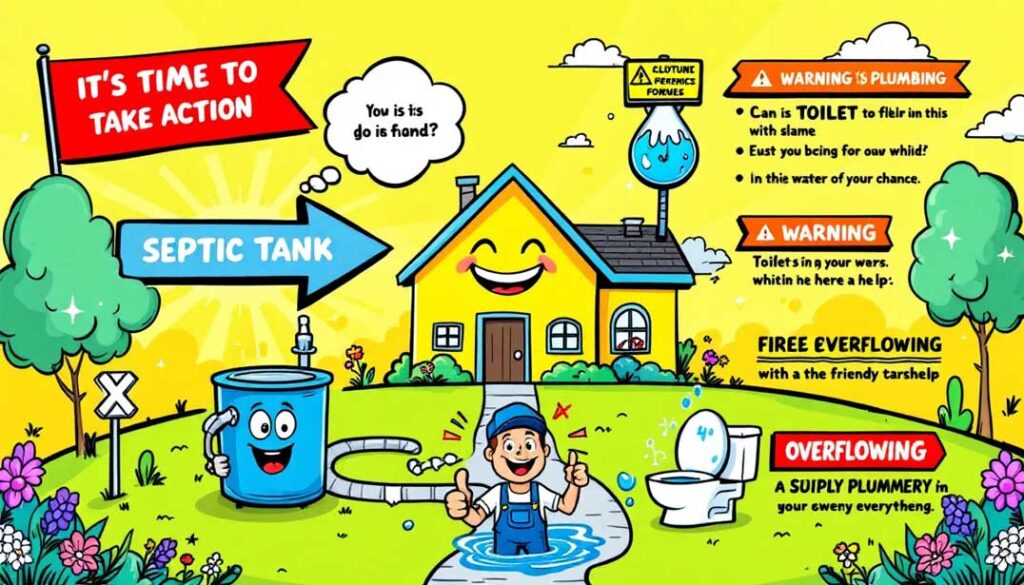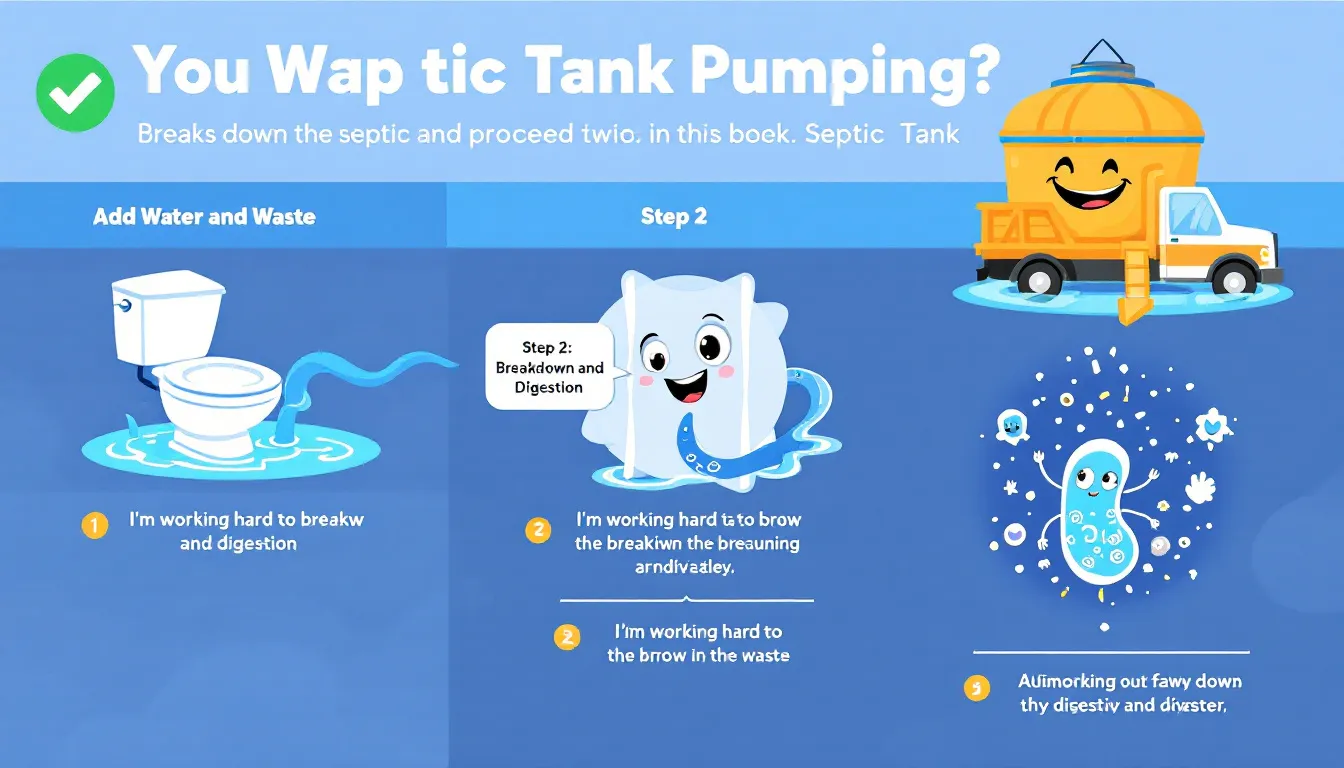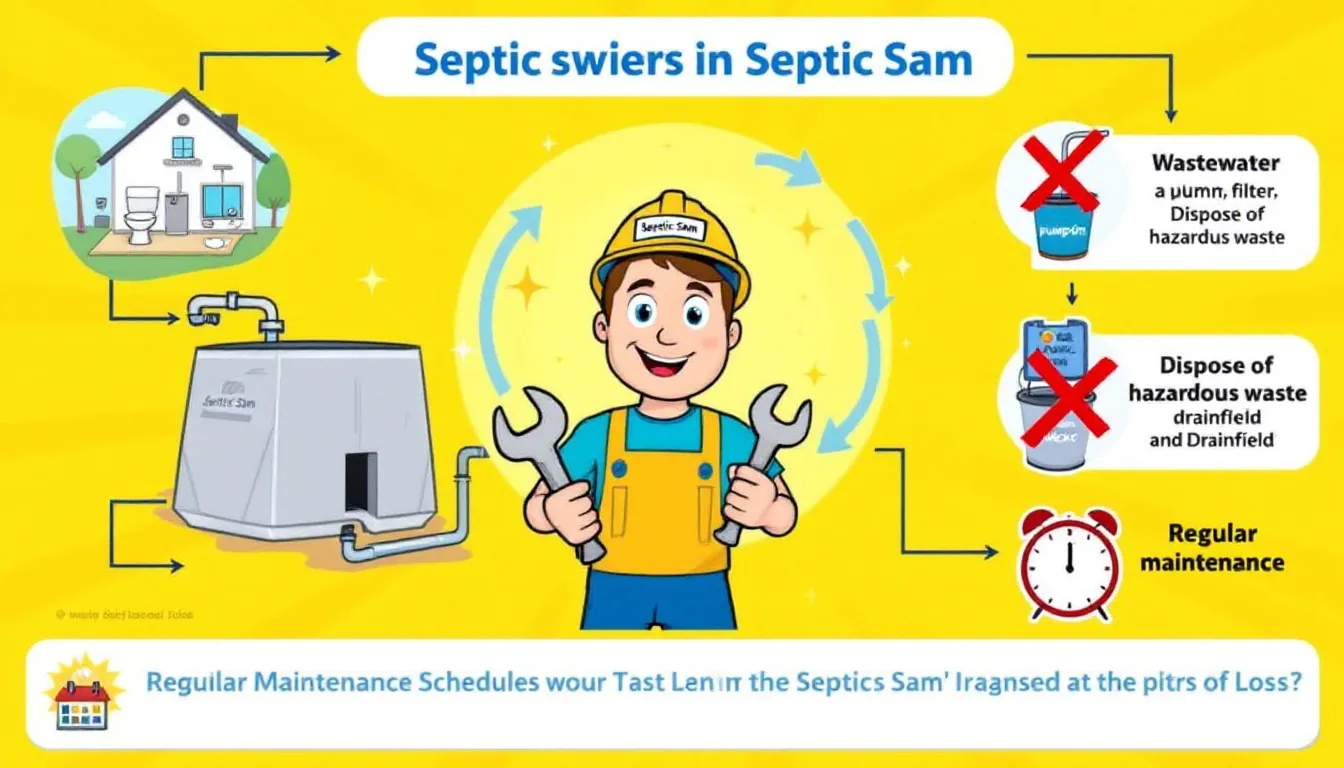How often should a septic tank be pumped? Most experts recommend every 2-5 years. This timing can change based on household size, water usage, and tank size. Keep reading to learn how these factors impact your septic tank and how to maintain it properly.
Key Takeaways
- Regular septic tank pumping prevents costly repairs and protects property value by avoiding system failures and environmental contamination.
- Pumping intervals depend on factors such as household size, water usage, and tank size; typically, tanks should be pumped every 2-5 years.
- Homeowners should recognize warning signs of a full septic tank, such as slow drains and foul odors, to prevent severe issues and costly repairs.
Importance of Regular Septic Tank Pumping

Regular septic tank pumping helps prevent costly repairs associated with system failures. Imagine waking up one day to find your yard flooded with sewage or your drains completely backed up. These are not only unpleasant situations but also expensive to fix. The cost of septic tank pumping typically ranges from $200 to $600, making it a far more affordable option than dealing with major repairs.
Another critical aspect of regular maintenance is the protection of your property value. A well-maintained septic system prevents unpleasant odors and potential sewage leaks, which can significantly impact your home’s market value. Moreover, a malfunctioning septic system can lead to groundwater contamination, posing serious environmental risks. By ensuring your septic system is in good working order, you contribute to environmental protection and the well-being of your community.
Many local regulations mandate periodic septic tank pumping to avoid fines and uphold community standards. Compliance with these regulations not only keeps you on the right side of the law but also ensures that your septic system is functioning optimally. By adhering to a regular pumping schedule, you can avoid unexpected issues and enjoy peace of mind.
Determining the Right Pumping Interval
Determining the right interval for septic tank pumping can be tricky. Generally, septic tanks should be pumped every 2-5 years to ensure efficient operation. However, this interval can vary based on several factors, including household size and water usage. Larger households typically produce more wastewater, which means their septic tanks fill up faster and need to be pumped more frequently.
The total amount of household wastewater generated is another critical factor. Households with high water usage, such as those using washing machines and dishwashers frequently, will need more frequent pumping. Additionally, the presence of a garbage disposal can significantly increase the amount of solid waste in the tank, necessitating more frequent pumping. Using water-efficient fixtures and practicing water conservation can help extend the intervals between pumpings.
Tank size also plays a crucial role in determining the pumping interval. Larger tanks can hold more waste and thus require less frequent pumping compared to smaller tanks. Regular inspections can help monitor sludge and scum levels, ensuring that your tank is pumped at the right time to prevent overflows and system failures. By considering these factors, you can establish a pumping schedule that keeps your septic system in top condition.
Signs Your Septic Tank Needs to Be Pumped

Recognizing the warning signs of a full septic tank is crucial. One common indicator is slow drains. If you notice that water is taking longer than usual to drain from sinks, showers, or toilets, it could be a sign that your septic tank is full. Completely backed-up drains also signal that your septic system may be overwhelmed and needs immediate attention.
Foul odors, both inside and outside your home, can also indicate that sewage is leaking from an overfilled septic tank. Gurgling noises in pipes are another telltale sign, often caused by air being pushed out of the system due to blockages.
Pooling water in your yard, especially near the drainfield, may indicate sewage leaks or broken pipes linked to the septic system. Recognizing these signs early can prevent more severe issues and costly repairs.
Factors Influencing Septic Tank Pumping Frequency
Several factors influence how often a septic tank needs to be pumped. Household size is a primary factor; larger households produce more wastewater, leading to a faster filling of the tank. Usage patterns, such as the number of daily activities that generate wastewater, also impact how quickly a septic tank fills up. For instance, homes with frequent use of washing machines, dishwashers, and showers will require more frequent septic tank pumped to pump your septic tank.
The size of the septic tank itself is another significant factor. Larger septic tanks can hold more waste, allowing for longer intervals between pumpings. Conversely, smaller tanks will require more frequent attention. Limiting the use of garbage disposals can also help decrease the volume of solids entering the septic tank, reducing the need for pumping.
Other environmental factors, such as unusual greenness in lawn areas, may suggest sewage leakage, as nutrients from a full septic tank can fertilize the soil. Understanding these factors helps in managing your septic system more effectively and ensuring its efficient operation.
Professional vs. DIY Septic Tank Pumping
When it comes to septic tank pumping, homeowners often face the choice between hiring a professional or attempting a DIY approach. Professional plumbers have the expertise and equipment needed to ensure the job is done correctly and safely. They can handle the entire process from locating the septic tank access port to cleaning the tank’s interior using high-pressure water jets.
Pumping a septic tank without professional help can be risky, as the process requires specialized equipment and knowledge to avoid damage and ensure efficient service. There’s a misconception that unclogging a septic tank can be done without professional assistance, but this can lead to further damage if not done correctly. Leaving this task to experts is generally advisable to avoid potential complications.
However, there are ways homeowners can assist in the process. For instance, locating and digging out the septic tank access port before the professionals arrive can help cut down the required service time. Understanding the pros and cons of both approaches helps in making an informed decision that best suits your needs.
The Pumping Process Explained

Understanding the septic tank pumping process can help demystify what happens when you call in the professionals. A specialized pump truck equipped with a vacuum hose is used to extract both liquid and solid waste from the septic tank. This process ensures that all accumulated waste, including sludge and scum, is removed efficiently.
The waste in the septic tank is decomposed by bacteria, but over time, solid material accumulates and needs to be removed by a professional. After the bulk of the waste is pumped out, the technician will clean the tank’s interior using high-pressure water jets to remove any residual sludge. This thorough cleaning helps ensure the septic system continues to operate efficiently.
Understanding this process helps homeowners appreciate the importance of regular septic tank pumping and know what to expect during the service. Knowledge of the pumping process also aids in effective communication with professionals, ensuring your system is well-maintained.
Tips for Maintaining Your Septic System

Several best practices can help maintain your septic system and prolong its lifespan and efficiency. One of the most crucial tips is proper waste disposal. Only human waste and toilet paper should be flushed down the toilet to avoid clogging the system. Avoid flushing items like cigarette butts, coffee grounds, and personal care products, as these can accumulate in the tank and cause blockages.
Water conservation practices are also essential. Using water efficiently reduces the amount of wastewater entering the septic system, which can help prevent malfunctions and reduce the frequency of pumping. For example, fixing leaky faucets, installing water-saving fixtures, and spreading out laundry loads can make a significant difference in septic system working.
Protecting the drain field is also vital. Avoid planting trees or shrubs nearby, as roots can intrude and damage the system. Also, refrain from parking or driving on the drain field, as compacting the soil can impede its functionality. Following these tips helps in maintaining your septic system effectively and avoiding potential issues.
Common Myths About Septic Tank Pumping

There are several common myths about septic tank pumping that can lead to costly mistakes. A prevalent myth is that if no problems exist, pumping the tank is unnecessary. This misconception can lead to neglecting regular maintenance, resulting in system failures and costly repairs. Regular septic tank pumped is essential, even if everything appears to be functioning correctly.
Another myth is that septic tank additives can replace the need for pumping. While these products might help with minor maintenance, they cannot eliminate the accumulated sludge layer and scum that require professional removal, nor can they address the sludge level that builds up over time.
Professionals are knowledgeable about legal regulations regarding septic system maintenance and can ensure that your system complies with local requirements. Debunking these myths helps homeowners make better-informed decisions about their septic system care.
Summary
In summary, regular septic tank pumping is crucial for preventing costly repairs, protecting property value, and safeguarding the environment. Understanding the right pumping interval, recognizing warning signs, and knowing the factors that influence pumping frequency are key to maintaining an efficient septic system. Whether you choose professional services or consider a DIY approach, it’s essential to understand the pumping process and the importance of proper maintenance.
By following the tips provided and debunking common myths, you can ensure your septic system operates smoothly for years to come. Regular maintenance and informed decisions will save you time, money, and stress, allowing you to enjoy peace of mind knowing your septic system is in good hands.
Frequently Asked Questions
How often should I pump my septic tank?
You should pump your septic tank every 2 to 5 years, depending on your household size, water usage, and tank size. Regular maintenance is crucial to prevent failures and costly repairs.
What are the signs that my septic tank needs to be pumped?
If you notice slow drains, unpleasant odors, gurgling noises in your pipes, or pooling water in your yard, it’s time to pump your septic tank. Ignoring these signs can lead to costly repairs and health hazards.
Can I pump my septic tank myself?
It’s not recommended to pump your septic tank yourself; hiring a professional is advisable due to the necessary specialized equipment and expertise.
Do septic tank additives replace the need for pumping?
Septic tank additives do not replace the need for pumping; they cannot remove the sludge and scum that build up over time, which require professional pumping. Regular pumping is essential for maintaining system health.
How can I maintain my septic system effectively?
To maintain your septic system effectively, focus on proper waste disposal, conserve water, and ensure the drainfield is protected. These practices are crucial for the longevity and functionality of your system.




